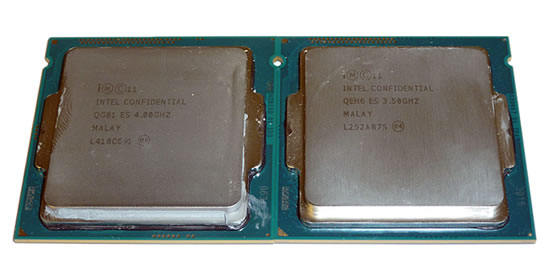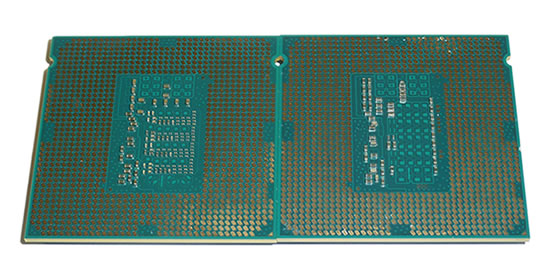Our Aim
To provide you with an overview on New And existing technologies, hopefully helping you understand the changes in the technology. Together with the overviews we hope to bring topical issues to light from a series of independent reviewers saving you the time And hassle of fact finding over the web.
We will over time provide you with quality content which you can browse and subscribe to at your leisure.
TekSpek 's

Intel 4th Gen Unlocked CPUs
Date issued:
Introduction
At the top tier of the processor market Intel faces little pressure from rival AMD, whose flagship CPU, the FX-9590, is only geared towards battling Intel's Core i5 range. This has led to a somewhat stagnant situation among Intel's Core i7 processors. Consumers still using a Core i7-2600K have found few reasons to make the jump to its two successors, the Core i7-3770K and Core i7-4770K. Performance differences alone no longer justify an upgrade so instead Intel has started to rely on the features of new motherboard platforms to kickstart the processor-upgrade cycle.
Intel is, however, trying to reinvigorate its desktop offerings through more speed and CPUs better tailored to overclocking. That's the primary reasoning behind Intel's refresh of the year-old Haswell architecture, but that also buys the company some more time to work on Haswell's successor, Broadwell.
Haswell refresh has an interesting spread, targeting the Core i7, Core i5 and Pentium segments with speed upgrades and various tweaks being brought in for similar prices.
Desktop Intel 'Haswell' Feature Comparison |
||||||
|---|---|---|---|---|---|---|
Intel Core i7-4790K |
Intel Core i7-4770K |
Intel Core i5-4690K |
Intel Core i5 4670K |
Intel Pentium G3258 |
Intel Pentium G3220 |
|
| Launch Date | Q3 2014 |
Q2 2013 |
Q3 2014 |
Q2 2013 |
Q3 2014 |
Q3 2013 |
| Cores | 4 |
4 |
4 |
4 |
2 |
2 |
| Threads | 8 |
8 |
4 |
4 |
2 |
2 |
| Unlocked multiplier | Yes |
Yes |
Yes |
Yes |
Yes |
No |
| CPU Clock Speed | 4.0GHz |
3.5GHz |
3.5GHz |
3.4GHz |
3.2GHz |
3.0GHz |
| CPU Turbo Speed | 4.4GHz |
3.9GHz |
3.9GHz |
3.8GHz |
- |
- |
| Smart Cache | 8 MB |
8MB |
6MB |
6MB |
3MB |
3MB |
| TDP | 88W |
84W |
88W |
84W |
53W |
53W |
| DDR3 Memory Support | 1,600 |
1,600 |
1,600 |
1,600 |
1,333 |
1,333 |
| Integrated Graphics | HD 4600 |
HD 4600 |
HD 4600 |
HD 4600 |
HD |
HD |
| IGP Execution Units | 20 |
20 |
20 |
20 |
10 |
10 |
| IGP Base Clock | 350MHz |
350MHz |
350MHz |
350MHz |
350MHz |
350MHz |
| IGP Max Clock | 1.25GHz |
1.25GHz |
1.20GHz |
1.20GHz |
1.10GHz |
1.10GHz |
| QuickSync Video | Yes |
Yes |
Yes |
Yes |
Yes |
Yes |
| Wireless Display | Yes |
Yes |
Yes |
Yes |
No |
No |
| ClearVideo HD | Yes |
Yes |
Yes |
Yes |
No |
No |
| InTru 3D | Yes |
Yes |
Yes |
Yes |
No |
No |
| Displays Supported | 3 |
3 |
3 |
3 |
3 |
3 |
| PCI Express Revision | 3.0 |
3.0 |
3.0 |
3.0 |
3.0 |
3.0 |
| PCI Express Configurations | Up to 1x16, 2x8, 1x8/2x4 |
Up to 1x16, 2x8, 1x8/2x4 |
Up to 1x16, 2x8, 1x8/2x4 |
Up to 1x16, 2x8, 1x8/2x4 |
Up to 1x16, 2x8, 1x8/2x4 |
Up to 1x16, 2x8, 1x8/2x4 |
| Max PCI Express Lanes | 16 |
16 |
16 |
16 |
16 |
16 |
| Turbo Boost | Yes |
Yes |
Yes |
Yes |
No |
No |
| Hyper Threading | Yes |
Yes |
Yes |
Yes |
No |
No |
| vPro | Yes |
Yes |
Yes |
Yes |
No |
No |
| TSX New Instructions | Yes |
Yes |
Yes |
Yes |
No |
No |
| AES New Instructions | Yes |
Yes |
Yes |
Yes |
No |
No |
| Socket | LGA1150 |
LGA1150 |
LGA1150 |
LGA1150 |
LGA1150 |
LGA1150 |
| US Box RRP | $340 |
$340 |
$242 |
$242 |
$72 |
$64 |
The Devil's Canyon
Dethroning the current flagship, the Core i7-4770K, is the Core i7-4790K. Internally, Intel developed the codename Devil's Canyon for this CPU because it is more than just a minor speed bump. The Core i7-4790K isn't any more expensive than its predecessor, but it still isn't cheap, priced at $340 (£250).
Devil's Canyon boasts the highest base and boost frequency of any Intel CPU to date. The stock frequency of 4GHz operates on all cores and the boost of 4.4GHz is for peak single-core performance. In reality, users will see 4.4GHz most of the time as many motherboard vendors have tuned their boards to ensure the Core i7-4790K runs consistently at 4.4GHz.
How have such large frequency gains been achieved, especially considering Haswell runs hotter and is less frequency-capable than past architectures like Sandy Bridge? The secret to Devil's Canyon is in the cooling. Intel has deployed what it calls 'next-generation polymer thermal interface material', or NGPTIM for short. Effectively this replaces the previous thermal interface material solution to help reduce temperatures to a level where the new CPU can cope with higher frequencies and voltages.

While NGPTIM is a definite improvement we're somewhat surprised Intel didn't revert back to fluxless solder. Such a solution was used on the renowned Sandy Bridge CPUs as well as Intel's HEDT CPUs - Sandy Bridge-E and Ivy Bridge-E. Fluxless solder is capable of significantly higher heat transfer than even the most efficient thermal paste.
An additional enhancement to the Core i7-4790K comes in the form of improved power delivery. Devil's Canyon features additional power-smoothing capacitors on the underside of the processor which provide the stable power delivery needed to reach the speed-demon stock frequencies of 4.0GHz to 4.4GHz. The combination of improved thermals and power delivery should level out the overclocking playing field for Haswell and minimise the extreme variance seen on the Core i7-4770K.

The new Core i7-4790K uses an identical LGA 1150 form factor meaning it will drop right into any 9-Series motherboard and work just fine. Furthermore, despite Intel's initial caution, the Core i7-4790K will also function without a hitch in existing 8-series motherboards. Most motherboards will require a BIOS update for proper compatibility, and the marginally increased TDP shouldn't pose an issue either - the 88W TDP of the Core i7-4790K is only four watts higher than the product it succeeds.
With a higher stock frequency, better overclocking and cooler operation, the Core i7-4790K is the go-to choice for the enthusiast making use of Intel's LGA 1150 platform.
Core i5-4690K
One level below the flagship Core i7 part is the popular unlocked Core i5 variant which also gets a minor upgrade. The Core i5-4670K has been speed-bumped by an additional 100MHz to form the Core i5-4690K. That 100MHz boost brings barely noticeable increases in performance in benchmarks but for new buyers investing into the LGA 1150 platform it certainly makes sense to get the faster part when it has the same MSRP as its predecessor. The extra 100MHz in frequency results in an additional 4W to the TDP, just like the Core i7-4790K, suggesting the voltage has been upped a little, too.
Summary
Intel's Haswell Refresh brings the Core i7 and Core i5 segments up to scratch with ever-rising expectations among consumers who are now spoilt for choice, relative to what was on offer last year.
If you were in the market for a Core i7-4770K processor before today, forget it, purchase the Core i7-4790K instead. Available for the same money and with more performance where it counts, it is the fastest mainstream Intel processor available today.
Scan Computers will be selling the widest selection of Intel processors in the UK. Please head on over to here to see our listings.